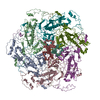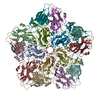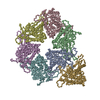[English] 日本語
 Yorodumi
Yorodumi- PDB-6iaw: Structure of head fiber and inner core protein gp22 of native bac... -
+ Open data
Open data
- Basic information
Basic information
| Entry | Database: PDB / ID: 6iaw | |||||||||||||||
|---|---|---|---|---|---|---|---|---|---|---|---|---|---|---|---|---|
| Title | Structure of head fiber and inner core protein gp22 of native bacteriophage P68 | |||||||||||||||
 Components Components |
| |||||||||||||||
 Keywords Keywords |  STRUCTURAL PROTEIN / STRUCTURAL PROTEIN /  bacteriophage / head fiber / bacteriophage / head fiber /  inner core protein inner core protein | |||||||||||||||
| Function / homology | Uncharacterized protein / Major head protein Function and homology information Function and homology information | |||||||||||||||
| Biological species |   Staphylococcus phage P68 (virus) Staphylococcus phage P68 (virus) | |||||||||||||||
| Method |  ELECTRON MICROSCOPY / ELECTRON MICROSCOPY /  single particle reconstruction / single particle reconstruction /  cryo EM / Resolution: 3.8 Å cryo EM / Resolution: 3.8 Å | |||||||||||||||
 Authors Authors | Hrebik, D. / Skubnik, K. / Fuzik, T. / Plevka, P. | |||||||||||||||
| Funding support |  Czech Republic, 4items Czech Republic, 4items
| |||||||||||||||
 Citation Citation |  Journal: Sci Adv / Year: 2019 Journal: Sci Adv / Year: 2019Title: Structure and genome ejection mechanism of phage P68. Authors: Dominik Hrebík / Dana Štveráková / Karel Škubník / Tibor Füzik / Roman Pantůček / Pavel Plevka /  Abstract: Phages infecting can be used as therapeutics against antibiotic-resistant bacterial infections. However, there is limited information about the mechanism of genome delivery of phages that infect ...Phages infecting can be used as therapeutics against antibiotic-resistant bacterial infections. However, there is limited information about the mechanism of genome delivery of phages that infect Gram-positive bacteria. Here, we present the structures of native phage P68, genome ejection intermediate, and empty particle. The P68 head contains 72 subunits of inner core protein, 15 of which bind to and alter the structure of adjacent major capsid proteins and thus specify attachment sites for head fibers. Unlike in the previously studied phages, the head fibers of P68 enable its virion to position itself at the cell surface for genome delivery. The unique interaction of one end of P68 DNA with one of the 12 portal protein subunits is disrupted before the genome ejection. The inner core proteins are released together with the DNA and enable the translocation of phage genome across the bacterial membrane into the cytoplasm. | |||||||||||||||
| History |
|
- Structure visualization
Structure visualization
| Movie |
 Movie viewer Movie viewer |
|---|---|
| Structure viewer | Molecule:  Molmil Molmil Jmol/JSmol Jmol/JSmol |
- Downloads & links
Downloads & links
- Download
Download
| PDBx/mmCIF format |  6iaw.cif.gz 6iaw.cif.gz | 475 KB | Display |  PDBx/mmCIF format PDBx/mmCIF format |
|---|---|---|---|---|
| PDB format |  pdb6iaw.ent.gz pdb6iaw.ent.gz | 393.2 KB | Display |  PDB format PDB format |
| PDBx/mmJSON format |  6iaw.json.gz 6iaw.json.gz | Tree view |  PDBx/mmJSON format PDBx/mmJSON format | |
| Others |  Other downloads Other downloads |
-Validation report
| Arichive directory |  https://data.pdbj.org/pub/pdb/validation_reports/ia/6iaw https://data.pdbj.org/pub/pdb/validation_reports/ia/6iaw ftp://data.pdbj.org/pub/pdb/validation_reports/ia/6iaw ftp://data.pdbj.org/pub/pdb/validation_reports/ia/6iaw | HTTPS FTP |
|---|
-Related structure data
| Related structure data |  4440MC  4435C  4436C  4437C  4438C  4442C  4449C  4450C  4451C  4453C  4454C  4455C  4456C  4457C  4458C  4459C  6iabC  6iacC  6iatC  6ib1C  6q3gC M: map data used to model this data C: citing same article ( |
|---|---|
| Similar structure data |
- Links
Links
- Assembly
Assembly
| Deposited unit | 
|
|---|---|
| 1 |
|
- Components
Components
| #1: Protein | Mass: 46954.941 Da / Num. of mol.: 6 / Source method: isolated from a natural source / Source: (natural)   Staphylococcus phage P68 (virus) / References: UniProt: Q859I3 Staphylococcus phage P68 (virus) / References: UniProt: Q859I3#2: Protein | Mass: 6922.464 Da / Num. of mol.: 6 / Source method: isolated from a natural source / Source: (natural)   Staphylococcus phage P68 (virus) / References: UniProt: Q859I2 Staphylococcus phage P68 (virus) / References: UniProt: Q859I2#3: Protein | Mass: 5720.042 Da / Num. of mol.: 3 / Source method: isolated from a natural source Details: Poly alanine chain fitted to the density of head-fiber Source: (natural)   Staphylococcus phage P68 (virus) Staphylococcus phage P68 (virus)#4: Protein/peptide |  Earth's inner core Earth's inner coreMass: 3507.314 Da / Num. of mol.: 3 / Source method: isolated from a natural source Details: Poly alanine chain fitted to the density of the inner core protein bound to hexon adjacent to portal Source: (natural)   Staphylococcus phage P68 (virus) Staphylococcus phage P68 (virus) |
|---|
-Experimental details
-Experiment
| Experiment | Method:  ELECTRON MICROSCOPY ELECTRON MICROSCOPY |
|---|---|
| EM experiment | Aggregation state: PARTICLE / 3D reconstruction method:  single particle reconstruction single particle reconstruction |
- Sample preparation
Sample preparation
| Component | Name: Staphylococcus phage P68 / Type: VIRUS / Entity ID: all / Source: NATURAL | ||||||||||||||||||||
|---|---|---|---|---|---|---|---|---|---|---|---|---|---|---|---|---|---|---|---|---|---|
| Molecular weight | Value: 19.7 MDa / Experimental value: NO | ||||||||||||||||||||
| Source (natural) | Organism:   Staphylococcus phage P68 (virus) Staphylococcus phage P68 (virus) | ||||||||||||||||||||
| Details of virus | Empty: NO / Enveloped: NO / Isolate: STRAIN / Type: VIRION | ||||||||||||||||||||
| Natural host | Organism: Staphylococcus aureus / Strain: dTarM 4220 | ||||||||||||||||||||
| Virus shell | Name: Capsid / Diameter: 480 nm / Triangulation number (T number): 4 / Diameter: 480 nm / Triangulation number (T number): 4 | ||||||||||||||||||||
| Buffer solution | pH: 8 | ||||||||||||||||||||
| Buffer component |
| ||||||||||||||||||||
| Specimen | Conc.: 2 mg/ml / Embedding applied: NO / Shadowing applied: NO / Staining applied : NO / Vitrification applied : NO / Vitrification applied : YES : YES | ||||||||||||||||||||
| Specimen support | Grid material: COPPER / Grid mesh size: 200 divisions/in. / Grid type: Quantifoil R2/1 | ||||||||||||||||||||
Vitrification | Instrument: FEI VITROBOT MARK IV / Cryogen name: ETHANE / Humidity: 100 % / Chamber temperature: 293 K / Details: blot time 2s; blot force -2; 3.6 ul of sample |
- Electron microscopy imaging
Electron microscopy imaging
| Experimental equipment |  Model: Titan Krios / Image courtesy: FEI Company |
|---|---|
| Microscopy | Model: FEI TITAN KRIOS |
| Electron gun | Electron source : :  FIELD EMISSION GUN / Accelerating voltage: 300 kV / Illumination mode: FLOOD BEAM FIELD EMISSION GUN / Accelerating voltage: 300 kV / Illumination mode: FLOOD BEAM |
| Electron lens | Mode: BRIGHT FIELD Bright-field microscopy / Nominal magnification: 75000 X / Nominal defocus max: 3 nm / Nominal defocus min: 1 nm / Cs Bright-field microscopy / Nominal magnification: 75000 X / Nominal defocus max: 3 nm / Nominal defocus min: 1 nm / Cs : 2.7 mm / C2 aperture diameter: 70 µm / Alignment procedure: COMA FREE : 2.7 mm / C2 aperture diameter: 70 µm / Alignment procedure: COMA FREE |
| Specimen holder | Cryogen: NITROGEN / Specimen holder model: FEI TITAN KRIOS AUTOGRID HOLDER |
| Image recording | Average exposure time: 1 sec. / Electron dose: 21 e/Å2 / Detector mode: INTEGRATING / Film or detector model: FEI FALCON II (4k x 4k) / Num. of grids imaged: 2 / Num. of real images: 2891 |
| Image scans | Width: 4096 / Height: 4096 / Movie frames/image: 7 / Used frames/image: 1-7 |
- Processing
Processing
| EM software |
| ||||||||||||||||||||||||||||||||||||||||
|---|---|---|---|---|---|---|---|---|---|---|---|---|---|---|---|---|---|---|---|---|---|---|---|---|---|---|---|---|---|---|---|---|---|---|---|---|---|---|---|---|---|
CTF correction | Type: PHASE FLIPPING AND AMPLITUDE CORRECTION | ||||||||||||||||||||||||||||||||||||||||
| Particle selection | Num. of particles selected: 37218 | ||||||||||||||||||||||||||||||||||||||||
| Symmetry | Point symmetry : C5 (5 fold cyclic : C5 (5 fold cyclic ) ) | ||||||||||||||||||||||||||||||||||||||||
3D reconstruction | Resolution: 3.8 Å / Resolution method: FSC 0.143 CUT-OFF / Num. of particles: 28826 / Algorithm: BACK PROJECTION / Num. of class averages: 1 / Symmetry type: POINT | ||||||||||||||||||||||||||||||||||||||||
| Atomic model building | Protocol: AB INITIO MODEL / Space: REAL Details: The refinement was conducted on rigid body fitted major capsid proteins and Arstotzka proteins obtained from related structure of 6IAT; EMD-4438. The chains were fitted into hexon adjacent ...Details: The refinement was conducted on rigid body fitted major capsid proteins and Arstotzka proteins obtained from related structure of 6IAT; EMD-4438. The chains were fitted into hexon adjacent to portal of P68 capsid obtained from 5-fold symmetrized reconstruction. Subsequently, poly-alanine chains were manually built into densities corresponding to N-terminal part of head-fiber (chain IDs H,K,L) and C-terminal part of inner core protein (chain IDs X,Y,Z). The map was masked according to the related pdb in chimera, normalized and put into several rounds of a real space refinement in Phenix. | ||||||||||||||||||||||||||||||||||||||||
| Atomic model building | PDB-ID: 6IAT Accession code: 6IAT / Source name: PDB / Type: experimental model |
 Movie
Movie Controller
Controller









 PDBj
PDBj